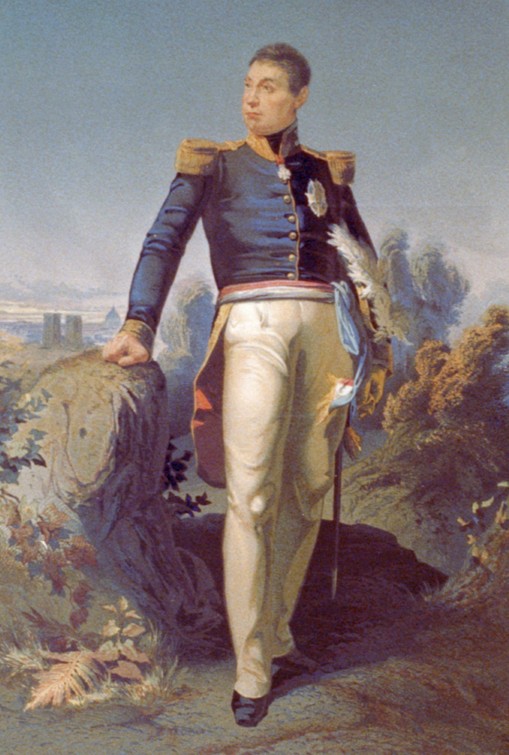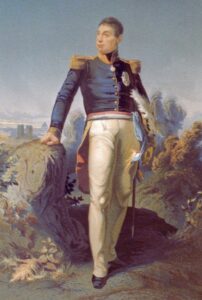Gilbert du Motier, Marquis de Lafayette
The visit of General Lafayette to the United States in 1824–1825 was the occasion for a yearlong celebration unmatched in American history.

Courtesy of Library of Congress Prints and Photographs Division.
A print showing the Marquis de Lafayette, full-length portrait, in uniform.
The visit of General Lafayette to the United States in 1824–25 was the occasion for a yearlong celebration unmatched in American history. The former Marquis de Lafayette (he had relinquished the title) was then the only living Revolutionary War general. When he extended his triumphal tour to the state of Louisiana, he conferred a symbolic unity on a region still seen as suspiciously foreign by Anglo-Americans.
Ever since he fought in the Revolution, Lafayette had devoted himself to the American nation, supporting its cause militarily, financially, and diplomatically. Among his devoted American friends were John Adams, Thomas Jefferson, James Madison, James Monroe, and George Washington’s family. In February 1824 President James Monroe invited Lafayette to return to the United States as “the guest of the nation” with all expenses paid.
Lafayette arrived in New York harbor August 14, 1824, to a tumultuous welcome. The actual man was almost lost in the patriotic frenzy of public receptions, parades, and military reviews. Mountains of souvenirs were produced: Lafayette’s image appeared on sashes, badges, gloves, jewelry, programs, paper items, vases, pitchers, banners, buttons, transparencies, and bowls.
It wasn’t just the public hoopla in the cities on his itinerary that mushroomed, but the itinerary itself. All twenty-four states of that time insisted on the honor of a visit. Louisiana felt particularly entitled to see Lafayette because he was French. Without the ubiquity of steamboats on southern and western rivers, traveling such a great distance in a few months would have been impossible. It would be an amazing feat—no one had ever traveled so far and so fast in the United States. The elderly and lame Lafayette set off by steamboat on February 23, 1825, on a trip planned like a military operation.
While he traveled southward, New Orleans prepared its welcome. He would be lodged at the Cabildo. The wealthy of the city lent furniture, carpets, window hangings, chandeliers, linens, china, and silver. In the Place d’Armes, the square facing the Cabildo, a triumphal arch was built of wood covered with canvas, towering sixty feet high. Designed by Joseph Pilié and painted by Antonio Fogliardi, it resembled Italian marble, decorated with banners bearing patriotic slogans.
Lafayette and his party came up the Mississippi River from Mobile aboard the steamboat Natchez in the pouring rain; on April 11, the governor and other dignitaries officially welcomed Lafayette to Louisiana at the Chalmette battlefield. Many Americans had opposed Louisiana’s statehood because of its French background. In his opening speech, Lafayette asserted, “In this state, daily evidence is given of the fitness of a French population for a wise use of free institutions and for self-government.”
The rain continued as he was welcomed in New Orleans. He was honored with banquets, balls, theatrical performances (including plays and music written in his honor), concerts, Masonic ceremonies, and military reviews. The general’s appearance anywhere, especially at the theater, brought everything to a halt as the audience and cast cheered and sang the “Marseillaise.”
When it finally stopped raining on April 13, the city created a night of illuminations. Private homes and public buildings were bedecked with lights and transparencies. At the Place d’Armes, colored lanterns filled the trees, pyramids of fire adorned its four corners, and the railing and gates were traced in light. The triumphal arch in the center was resplendent.
As in Lafayette’s visits to other cities, the greater part of each day was taken up with paying and receiving ceremonial calls. In New Orleans, old friends, Revolutionary companions, politicians, military officers, Masons, prominent local citizens, and all their families came to call. Among the delegations meeting with Lafayette on April 14 was a contingent of free men of color, militia veterans who had fought at the Battle of New Orleans, warmly welcomed and praised by Lafayette.
While he was in New Orleans, Lafayette had hoped to gain clear title to a large tract of land granted him by Congress. Land speculation was one of the favored money-making devices of the early republic, and he expected to make a profit when he sold the land. Nothing was concluded, however, and the claim was passed on to his heirs.
Relics of Lafayette’s visit were treasured by many New Orleanians. Subsequently, a street, a handsome square, and a large upriver suburb, a portion of which became today’s Garden District, were named in his honor. One of the greatest marks of esteem Lafayette bestowed on New Orleans was the length of his stay. Five days marked a major visit; most cities were granted at most a day, perhaps only a few hours.
Beginning at dawn on April 15, the day of Lafayette’s departure, some 10,000 people assembled at the riverfront to bid him farewell. His boat stopped at Baton Rouge for a reception and banquet, but steamed away before nightfall, keeping to a tight schedule. Lafayette had promised to help celebrate the fiftieth anniversary of Bunker Hill before he left the United States forever on September 10, 1825.
Lafayette’s visit to Louisiana carried enormous symbolic freight for its French Creole inhabitants. Brought willy-nilly under American sovereignty by the Louisiana Purchase of 1803, they had been portrayed by New England politicians as hopelessly foreign and un-American when they applied for statehood. But in the twenty-two years since Louisiana’s acquisition, the state had boomed and proven its loyalty. Its capital had been the site of an overwhelming victory over the British at the Battle of New Orleans and was fast becoming one of the nation’s major ports. Ultimately, Lafayette’s visit to Louisiana underscored the obvious: The state was no longer foreign territory but had become truly part of the United States.
